#Raymond E Feist
Text
Vancian Casting
One of the key mechanics of D&D is Vancian spellcasting where the spellcasters have a certain number of "spell slots" that they can prepare in a given day. Magic Users (the precursors to wizards, warlocks, and sorcerers) would "memorize" spells and the Clerics (and later Paladins) would "pray" for spells. Later, druids and rangers would be added which would also pray for spells.
This was one of my biggest stumbling blocks for getting D&D magic because it didn't make sense to me that you just stopped knowing something because you used it once. And while I get the idea of becoming tired, the spell slot system was too rigid to represent how exhaustion works.
The Concept Broken Down
This is called Vancian magic because it is based on the Dying Earth novels by Jack Vance. None of which I've read, which probably contributes to my just not meshing well with Vancian casting.

In the series, magic was released by using magical words and the human mind could only hold a limited number of syllables in mind at a time and using them would wipe the knowledge from their mind. So the wizards would have to study their tomes everyday to regain their ability to perform magic. This mechanic was carried over to priests save that they would begin the day by asking their god for specific miracles. In both cases, the spellcaster needed to pick specific spells and couldn't change over to different ones if they decided that they didn't need a prepared spell after-all.
Raymond Feist, the novelist who created the Midkemia setting and wrote the Riftward novels, did some earlier work on D&D and refined this narrative into the idea that spells were long rituals but wizards had eventually built in a cutoff at the end where they could leave a spell unfinished save for a word or two. They would then have that spell basically just hanging on their word to release. Mechanically similar, though the narrative is different.

I have read some of that series and his approach to Vancian casting was the first one that made some sense. It accounted for why you "forgot" a spell. You didn't, you just expended the ritual and didn't have time to set it up again. And it explained why you had to prep spells ahead of time. Again there would be no time to do the ritual on the fly. However, it still didn't account for why the spell slots were rigidly structured on a level basis. And I still felt that surely you could do something with all that raw power even if you couldn't shape something intricate.
My Epiphany
What finally made the idea of magic slots work for me ... sort of ... is the video game Nioh 2. But even here there aren't slots, there's a "capacity" and each technique uses up a certain number of points of that capacity. But that's not the big "ohhh" moment for me here.
In Nioh 2, your Onmyou (and Ninjutsu) are physical tools and talismans which are consumed. So you would go to the nearest shrine and choose to "Ready Jutsu"

This would bring you to a menu show your capacity and what skills you've learned.

And then you could assign those pieces of gear to one of your eight hot-key slots. Resulting in me having a bunch of stuff I want available immediately and some items I use between fights so I can take my time about activating them and thus don't need to use one of my limited hot-buttons.

The main thing that made me go "That makes Vancian magic make so much more sense" even more than Feist's rituals with the cut-offs. Is that each of these tools is a consumable item and once you use it, you have to make another one.
The energy isn't something you have on tap where rituals are used to funnel it. It is something you take effort and time to create and then you expend it like a grenade, potion, or ammunition.
On top of this, Nioh 2 does have powers that you can use repeatedly over time as power builds up in the form of yokai powers and yokai shift. Both of which hinge on your nature as half-yokai and the yokai spirits that have allied with you. For these powers you have two pools of endurance that build up over time, one of which you can use piecemeal to summon your yokai powers and one of which you have to build up to a specific threshold in order to shift into a yokai form.
So they both have consumable one-use spells in the way D&D does in the form of Jutsu and inherent magical energy to fuel powers in the form of Anima (fueling yokai powers) and the Amrita Gauge (the threshold for changing into yokai form). But they are separated.
I'm going to set aside Anima and Amrita because they are basically "Sorcery that makes sense" and function by getting rid of spell slots.
The Jutsu is the method I'm focusing on here again because:
Each prepared "slot" represents a tool prepared using engineering, chemistty, mystical reagents, or appealing to spirits.
The stuff that makes the tools and talismans is external to the character.
The slots are not specifically numbered. As a note, point pools have been an alternative magic casting method since late 2nd edition.
This combination of creating a physical consumable and dropping the level-sorted slots was the thing that made Vancian casting make so much more sense. But then again... this wouldn't be Vancian casting, would it?
Side note, another facet of Nioh 2's "Jutsu" system is that leveling up the skill does not improve the damage that technique does. Fire Shot I, Fire Shot II, and Fire Shot III all base their damage on your Magic rating and other inherent bonuses.
What leveling up the skills does is increase their efficiency and increase the maximum number you can craft. For example
Fire Shot I: Prepare 1-6 fire shot talismans at 1 capacity each.
Fire Shot II: Prepare 1-8 fire shot talismans at 0.8 capacity each
Fire Shot III: Prepare 1-10 fire shot talismans at 0.7 capacity each.
This is largely just neat and not part of my epiphany on Nioh 2 and Vancian casting.
Now, you can't just change D&D to match that. It would be a completely different flavor of magic. But it is curious to see how it things would have developed if they had taken this track.
What If...
The big change here is that this mode of "magic" is more akin to being a D&D artificer than a D&D wizard. As you can also see, it would also have worked with some rogue abilities too with craftable thrown weapons, grenades, and medicines.
My suspicion is that if D&D had started with the assumption of wizards and clerics preparing relics and talismans between fights then it would be the sorcerer that was a late comer rather than the artificer. Though the artificer might not have been called such since it would be the base assumption.
I kind of suspect if the sorcerer had been introduced in that environment we would have heard something akin to the "no sci-fi in my fantasy" we get with artificers today but instead we'd be having "no mutant superheroes in my fantasy" with sorcerers.
#rpg#ttrpg#Nioh 2#spell slots#vancian casting#raymond e feist#midkemia#what if D&D started with casters brewing potions crafting talismans and writing scrolls.#dungeons and dragons
8 notes
·
View notes
Text

I seem to have accidentally stuck to a theme this month 😅 and only after reading The Study of Poisons did I realise how much, coz even the two without Magician in the title still have magicians as a major part of the story 😅
#poisonstudy#thestudyofpoisons#mariavsnyder#magician#the secrets of the immortal Nicholas flamel#michael scott#the magicians#lev grossman#raymond e feist#riftwar saga
7 notes
·
View notes
Text
Legends
Because this was an anthology of so many different authors, it's a little hard to rate. I ended up skipping a lot because I just didn't like the authors.
Stephen King : The Little Sisters of Elura : 3.5 maybe 4 stars. As usual, there are things I liked and things I didn't like with King's writing. That being said, I haven't read the Gunslinger series yet but was able to read this snippet with ease and rather enjoyed it.
Terry Pratchett : The Sea and Little Fishes : 5 stars. Another series I haven't read yet (but is definitely on my tbr pile), I absolutely adored this. Fun and magical and just overall delightful. Highly recommend for a short, light reading.
Terry Goodkind : The Debt of Bones : 4 stars. I don't think I've ever read any of Goodkind's work, but I found this one interesting of a read and might end up adding the rest of the series to my tbr. I liked the characters and the magic and the world, so it seems likely I'll eventually pick it up.
Orson Scott Card : The Grinning Man : Skipped (Read 1.5 pages and just couldn't)
Robert Silverberg : The Seventh Shrine : Skipped (Read the introduction and was not interested)
Ursula K. Le Guin : Dragonfly : 5 stars. Loved rereading this story (it's found in the Tales of Earthsea volume as well). But I love Le Guin and Earthsea so that will not surprise anyone that knows me.
Tad Williams : The Burning Man : Skipped (read 2.5 pages and just....it's meh. Maybe if I had read the series this would feel like it's going somewhere)
George R.R. Martin : The Hedge Knight : Skipped on Principle. I don't like Martin's writing in general and so I didn't even bother.
Anne McCaffrey : Runner of Pern : 5 stars. Loooooved this. It was so nice to revisit Pern in a story I've never read before. It has me so excited to get to the Pern Reread I'm planning in 2023.
Raymond E. Feist : The Wood Boy : Skipped. (read 5 pages but it was so drrrry.)
Robert Jordan : New Spring : Skipped (meh..........It just didn't interest me.....Rating may change in the future if I ever try the Wheel of Time Series)
Overall, I'll be keeping this brick of a time because of the 3 stories that I enjoyed until such a time I find them in smaller volumes to put on my bookshelf.
Read : Nov 27th - Dec 10th 2022
Rating : 4 Stars
#legands#stephen king#terry pratchett#terry goodkind#orson scott card#robert silverberg#ursula k le guin#tad williams#george r r martin#anne mccaffrey#raymond e feist#robert jordan#so many authors#fantasy#science fiction#large books#pern#tales of alvin maker#memory sorrow and thorn#sword of truth#the riftwar saga#the dark tower
0 notes
Text
#I've been have nostalgic thought on my series and thought I'd see how people feel about theirs#a song of ice and fire#asoiaf#Dune#Wheel of Time#The Dark Tower#The Riftwar Cycle#Shannara#the Shannara chronicles#george rr martin#frank herbert#stephen king#raymond e. feist#raymond e feisty#terry brooks#Robert Jordan#I assume asoiaf will sweep but I keep my hopes up for others with a fighting chance#macs book poll
1K notes
·
View notes
Text
Now that I'm reading books by Pratchett's male contemporaries in the 80s and 90s, I'm realising just how ridiculiously ahead of the curve Terry was in terms of writing complex female characters.
I'm reading through the Riftwar Cycle by Raymond E Feist at the moment and (aside from the sub-series that he co-wrote with Janny Wurts) his writing of female characters is incredibly limited (at least thus far; I'm on 'Shadow Of a Dark Queen' at the moment). Virtually every female character is allocated the singular role of either mother, love interest to a male hero, seductive villianess or sex worker.
This book came out in 1994 but it may as well be 1974 given how one-note the female characters are. And that's not even getting into the constant fridging.
Hoping that Feist's writing for women gets better as the series progresses because jeez...
#booklr#terry pratchett#raymond e feist critical#i think i may read some of janny wurts books#because i'm starting to think it was her side of the writing in 'the empire trilogy' that i enjoyed#i could overlook it somewhat during the initial magician trilogy because it was feist's first releases and he wrote it in the early 80s#but this? raymond get it together already you wrote three books with someone who knew how to do this
154 notes
·
View notes
Text

vote yes if you have finished the entire book.
vote no if you have not finished the entire book.
(faq · submit a book)
#fantasy#Mistress of the Empire#Raymond E. Feist#Janny Wurts#The Empire Trilogy#books#poll#l: English#result: no
20 notes
·
View notes
Text
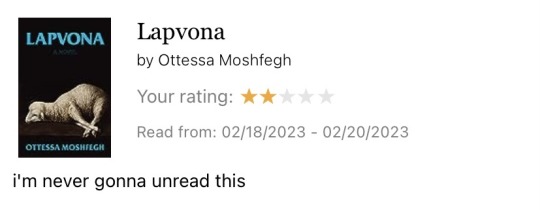
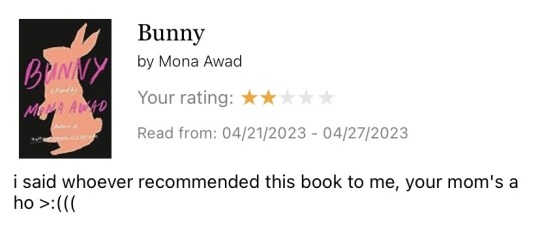





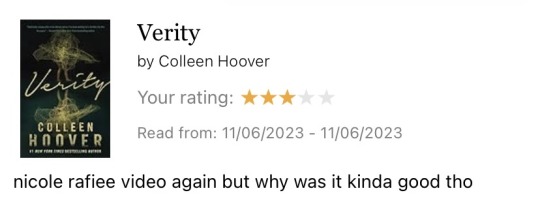
reviews i have written this year on goodreads: a collection
#i think i'm the funniest person alive but no one agrees :/#rose shut up#ottessa moshfegh#mona awad#julia fox#colleen hoover#ali hazelwood#raymond e. feist#c.j. leede
57 notes
·
View notes
Text
“Love doesn’t demand; it accepts. It has taken me my life to learn this."
Raymond E. Feist, Mistress of the Empire
#bookaddict#book quotes#booknerd#booklr#reading#book#booklover#books#bookworm#quote#raymond e. feist#mistress of the empire
5 notes
·
View notes
Text
“There are two kinds of strength. Power and the ability to wield it is obvious, but resilience, the ability to resist power, is the other.”
- Raymond E. Feist ‘The Chaoswar Saga: Magician's End’
3 notes
·
View notes
Text
Wanted: Recommendations for Horror Novels!
I have just started to read some books in the horror genre but don't know what I like just yet. I recently read the following books:
- Faerie Tale by Raymond E. Feist (loved)
- Slewfoot by Brom (sort of liked)
- Between Two Fires by Michael Beuhlman (loved)
What are some good introductory horror books you recommend? And/or, what book(s) got you interested in the horror genre?
#book recommendations#books#horror#horror books#Slewfoot#Between Two Fires#Michael Beuhlman#raymond e. feist#Brom
4 notes
·
View notes
Text
AUTHOR EXTRAORDINAIRE

'Writing is hard work; its also the best job Ive ever had.'
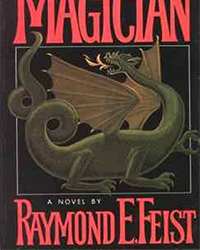
'I don't write fantasy; I write historical novels about an imaginary place.'
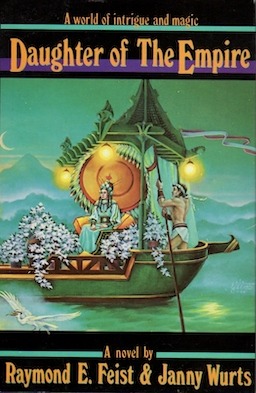
'I won't say that writing is therapy, but for me, the act of writing is therapy. The ability to be productive is good for my mental health. It's always better for me to be writing than vegetating on some couch.'
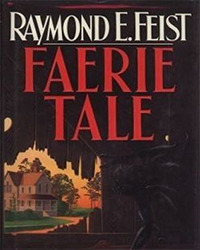
'Mostly I'm writing about people, so I feel constrained to take with me my view of people, my curiosity about how people choose the things they do and why they come to certain decisions in a certain fashion and all the things that drive most writers.'
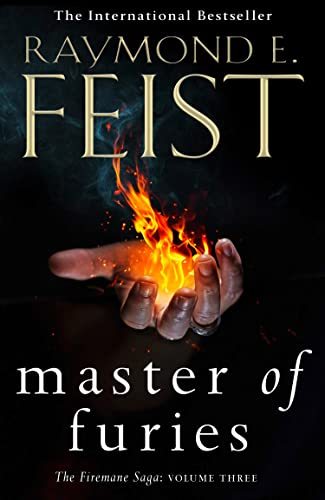
Author Extraordinaire Raymond E Feist
#raymond e. feist#fantasy#author extraordinaire#writing advice#writing inspiration#writblr#books#literature
4 notes
·
View notes
Text
At some point I should re-read Feist's Riftwar books. It's been 5+ years since I read them. I've kept a bunch of them on my shelf for mostly nostalgia reasons at this point.
They were among my first fantasy series obsessions when I was 13/14. I'd love to see if I still like them. 😜
#mostly i remember the big wifeguy energy 90% of the MCs had#cara reads 2024#riftwar#raymond e. feist
3 notes
·
View notes
Text
I love a good story about an orphan being trained in magic and becoming one of the most powerful wizards ever. No, non that one. I'm referring to Pug of Midkemia, known as Milamber upon the Tsurani.
18 notes
·
View notes
Text
A Pretentious Bitch's Review of Magician: Apprentice by Raymond E. Feist

Rating: 65/100
Summary: A tropey high fantasy journey through a DND-esque, LOTOR-adjacent fantasy world.
I have actually read this book before, as a kid. I don't remember how old I was at the time, but I was much newer to fantasy and much less critical. I remember liking this book pretty well, but getting bored after the first sequel, and honestly that's an assessment I kind of stand by as an adult. Be warned, my review contains spoilers.
Plot: The central plot of the story is an invasion of the fantasy world of Midkemia by another world through "rift portals" by an empire known as the Tsurani. The majority of the story centers around the journey that the central party makes to the capitol in order to ask the king for aid in repelling the invaders, with a pivot towards the end to being about the warfare between the main characters and the invaders. It's also a coming of age for the main character, Pug, who, through several time skips, changes and develops. At the beginning I thought that the story was going to revolve around Pug's development as a magician, since he starts the story a poor magician, then has an incident where he accidentally uses magic to save the princess. Then he proceeds to never use magic again or really learn anything more about magic.
Some aspects of the plot are straight out of Lord of the Rings, especially the sequence where the party goes down into dangerous old unused Dwarven mines in order to pass under the mountains, where they face a dangerous enemy and are forced to leave one of their party behind. Also speaking of that incident, the author set up some tension where Pug was meant to believe that Tomas was lost, then immediately undercut it by showing the reader in the very next chapter that Tomas was alive. Additionally, Pug's reaction to finding out later on that Tomas was alive was never shown.
The early portions of the book that take place at the castle are enjoyable, and so is the journey that the main party makes. However, the war scenes at the end of the book become dull quickly, and I felt bogged down while reading them. The broadening of the story and the loss of connection with Pug and Kulgan, my two favorite characters, bored me.
Prose Quality: Nothing spectacular. It's fairly serviceable fantasy prose, with some decent scenery descriptions, a tendency towards the simplistic, and some moments of hilariously bad writing that I feel any competent editor should have noticed. A standout illustration is "waving aside Tully's comments with a dismissive wave." The author, when he choses to foreshadow something, is also typically VERY heavy-handed with it.
**Characters: **I enjoy Kulgan (the magician) quite a lot, along with Tully, the priest. In my note as I was writing I kept writing "I love Kulgan" over and over again. I'm decently fond of Pug as a character, and I don't mind Tomas. Every single other character I could quite frankly take or leave.
I will also use the space to talk about the names. The names are SO funny, in that way that names in older works of fantasy tend to be. They range from extremely common real world names to comical fantasy names. The great wizard is named Marcos. The main character is named Pug. The king is named Rodric.
I also commend the author for his willingness to let his male characters cry and be immature. Pug is, at the start of the story, a very young man, and he acts like it for the vast majority of the book, in a way that is endearing rather than insufferable. He also cries, over his friend Tomas when he is lost in the mine, and over several other things throughout the story.
Worldbuilding: The worldbuilding, especially when it comes to magic, has some genuinely interesting bits, and I was enjoying the segments with Tomas' armor that he gets from the dragon that he finds in the mine as well (although of course some of the concepts there, especially the idea of a long dead civilization that had control over the dragons, is done to death [although to be fair it likely wasn't done to death at the time of publication]). The worldbuilding on elves, dwarves, and the kingdom in general is pretty typical stuff. This book was based on the author's dungeons and dragons game and it shows. I will say that the medieval aspect of medieval fantasy is REALLY well-handled in this book. Travel times seem relatively realistic, they use carrier pigeons for messages traveling long distances, the characters typically wear tunics and leggings, which, can I just say that most fantasy series don't have the balls to put their characters in leggings, and most of the clothes of the nobility are in garishly bright colors by modern standards, which is, once again, realistic. There is a lot of death in the course of battles, although all deaths are nameless soldiers, no named characters die. (Once again, this is the author's Dungeons and Dragons campaign). There is some genuinely interesting political stuff that pops up midway through the book, with suggestions that in order to repel the invasion the characters involved may have to commit treason, but nothing comes of it.
Action Sequences: Most of the action sequences don't feel very tense. The style is, in my opinion, a bit dry, and especially some of the later scenes while the war is ongoing felt a bit dry and were a slog to get through. Additionally, they felt as though they had very little stakes. All the combat was quite bloody (in a very early sequence in the forest with the Dark Brotherhood [Drow], the party loses more than half of the soldiers they were traveling with) but no named characters ever died, and any time the fate of a main character was in question, that character's fate was IMMEDIATELY shown to leave the reader in no doubt of their survival, which cuts any tension rather brutally.
Romance: Worse than Sanderson by a long shot. And Sanderson's got the excuse of being Mormon! I will give this book that it no longer appears that Carline (the princess) will be getting with Pug at the end of the story.
Female Characters: Carline is the only notable woman in the entire book. She is pretty cool to be honest and has a couple of good moments, but we only see Carline from her own perspective towards the end of the book. I hate her plotline with Roland, like so much, but I'm glad she got her chance to do some fighting towards the end. At about halfway through the book I found myself really missing the presence of women.
Gay?: Nope. Laughed a lot at the use of the term "glory hole" in a mining context though.
Racism?: I'm hesitant to be critical of the book on this front because I don't necessarily think holding a piece of 80s fantasy to a modern standard is a particularly useful activity, especially when there are MUCH worse books in the genre than this one, but I feel the need to put this out there: The Tsurani are pretty clearly Asian-coded. It's a bit sketchy.
Was It Worth It?: I got this book for a dollar at Goodwill, so I'd say I got my money's worth, and the hardback will look nice on my shelf so there's that. As for the time cost... I'd say yeah, I got a kick out of revisiting the early scenes of the book.
Will I Continue The Series?: This book is the first in a VERY long series. I have the hardback copy that contains both Magician: Apprentice and Magician: Master so I probably will read Magician: Master eventually, just because I have it already. As for the rest of the series after that, I'm going to say no.
Final Verdict: It's a bit derivative and a bit dated and a bit slow. I suspect that although I was once, I no longer am the target audience. Here's to hoping the rest of my 2024 reads score higher.
Review Word Count: 1367
#Void's 2024 reads#book review#genre: fantasy#author: Raymond E. Feist#Magician: Apprentice#publication year: 1992#original publication was in 1982 but I have the 10th anniversary revised edition#score range: 60s
2 notes
·
View notes
Text
Alright, so I finished Silverthorn by Raymond E. Feist; here's my thoughts.
I sorta remember this book being really bad for two things: one is having really bad romance scenes, and the other was just general "middle book syndrome". Neither of these things were as pronounced as I remember them being.
With the romance stuff, yeah, it was still there, and it still a bit hard to get through. A lot of this is due to Carline and Anita being very bare bones characters in general and their arcs are almost entirely defined by being someone else's love interest, while the men they're interested in get to have arcs that aren't centred on them. Despite there being other books where this is a less prominent problem in Feist's attempts at romance, it's still an issue here.
I think this was particularly noticeable for two reasons. One is that it's a very front-heavy problem. Basically all the main romance scenes happened in the first half of the book. The other is that once they start getting into the actual adventure, the women in the book all essentially disappear. Sure, they're mentioned a couple of times, but they're not active participants in the story, and even during the period of time they are, it's barely an active participation.
Still, this wasn't as prominent an issue with Silverthorn as I remember it being. The amount of scenes this is an issue in is fairly limited, and they're all in the first half. I think the real issue is that the female characters really aren't treated as independent entities, despite some of Feist's other books (such as Faerie Tale and the Empire trilogy) proving he is capable of writing women passably when he wants to.
The second problem I remember from this book, that it was bad for "middle book syndrome", was less pronounced than I remember it being, too. Yes, a lot of what happens here is just setting the stage for what happens in A Darkness At Sethanon, but the overall arc of this book (especially with Arutha's plotline) would have been fine as a standalone book as well.
Really most of the middle book syndrome-y stuff is in Pug's plotline. While the Arutha-centric storyline in this book has a definable beginning, middle, and end, with some clear sequel hook stuff that's meant to set the stage for the next book, Pug's doesn't really have that. It's basically all just stuff that's meant to be setting up what comes next.
I think my actual issue is that Silverthorn is a bit of a slog to get through. It's not exactly boring--some of it is quite interesting--but it isn't as captivating as some of other Feist's books. I think I probably just wrote that off as middle book syndrome because I didn't really understand what that was at the time.
I think I have a much more forgiving outlook on this book today than I did back then. While ten or fifteen years ago, I would have struggled to find anything I liked about the book, now I can tell you a couple of things.
One is just a technical thing. The book has a "our story so far" section at the start which summarises the events of Magician. The next book, A Darkness At Sethanon, also has this (though it also goes over the events of Silverthorn as well). This is something that I really wish later Riftwar books would have because this is a much better option than having passages that amount to "...and this is Main Guy, who's been in the last six books, and this is the important information which was covered there, but we'll go over it again now in case you missed it."
I get doing something like that is sometimes necessary because you can't assume that everyone reading any given book is reading them back-to-back, in the correct order, or is even aware that there were previous books. Still, having the "our story so far" summary is my preferred way of approaching this over the "character summary 100 pages in" passages.
The other is worldbuilding. One of the thing that Magician didn't do as well as I would have liked is flesh out some of the different groups that live within the Kingdom. Silverthorn doesn't really spend a lot of time doing this either, but it does at least start doing it. It talks a little bit about some of the traditions of the Hadati hill people, it introduces the Nighthawks as a group of assassins, and so on. To some extent, this is still the generic fantasy world sort of stuff that Magician's worldbuilding suffered from, but it does provide some of the depth to Midkemia that it really needed.
4 notes
·
View notes
Text

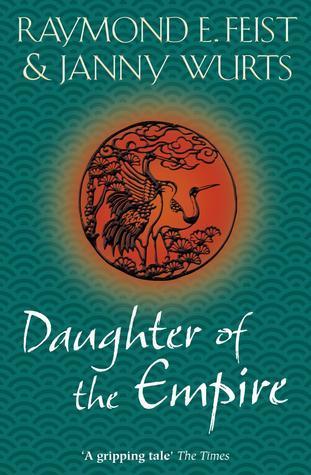
vote yes if you have finished the entire book.
vote no if you have not finished the entire book.
(faq · submit a book)
#fantasy#Daughter of the Empire#Raymond E. Feist#Janny Wurts#The Empire Trilogy#books#poll#l: English#result: no
18 notes
·
View notes